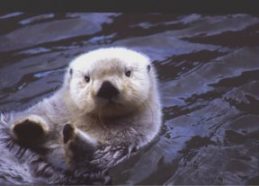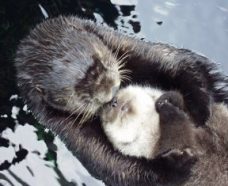Sea otters, kelp, and killer whales
Learning more about sea otters can help rescue the animals and save coastal ecosystems.
Share this:
- Share via email (Opens in new window) Email
- Click to share on Facebook (Opens in new window) Facebook
- Click to share on X (Opens in new window) X
- Click to share on Pinterest (Opens in new window) Pinterest
- Click to share on Reddit (Opens in new window) Reddit
- Share to Google Classroom (Opens in new window) Google Classroom
- Click to print (Opens in new window) Print
By Emily Sohn
Walk along a wild, rocky stretch of the Washington State coast and you might catch a glimpse of a furry creature bobbing on its back in the waves. The basking animal is likely to be a sea otter.
“They’re the teddy bears of the ocean,” says C.J. Casson. He’s curator of mammals and birds at the Seattle Aquarium.
 |
|
A sea otter lolling in the water.
|
| Seattle Aquarium |
Floating on a bed of seaweed or cracking a clam on its chest, a sea otter looks as if it doesn’t have a care in the world. Otter researchers such as Casson know better.
For 150 years, sea otters were hunted so heavily for their fur that, by 1910, they had disappeared from the waters off Washington and Oregon. They’ve made a comeback in Washington with help from scientists and conservationists.
But, according to ocean mammal researcher Ed Bowlby, Washington’s otters aren’t out of the woods yet. And other groups of sea otters in California and Alaska have taken a turn for the worse.
California otters seem to be getting sick more often than they used to. In Alaska, the rapid loss of sea otters turns out to have a shocking cause. Killer whales have started eating them.
An otter is “no more than a mouthful” for a killer whale, Bowlby says. But hungry killer whales aren’t finding enough of their preferred prey: seals and sea lions.
Bowlby works for the National Oceanic and Atmospheric Administration. He and other scientists are working to find out what new threats otters face and why Washington’s otters have done better than others. The research will shape a new plan to help otter populations thrive.
A furry warmth
Sea otters have not always been a rare sight. They once lived all along the Pacific coast, from northern Mexico to Alaska.
Unfortunately, their teddy-bear qualities were nearly their downfall. Friendly sea otters were easy for fur traders to hunt. And their pelts are especially thick and soft.
Unlike whales and sea lions, sea otters have no layer of blubber to keep themselves warm. They have only their thick fur for insulation. One square inch of it contains 1 million hairs—10 times as many hairs as on your entire head.
They also need a lot of food energy to keep warm. Bowlby says, “They eat pretty much anything they can grab onto.”
 |
|
A sea otter has thick fur to keep it warm in frigid waters.
|
| Seattle Aquarium |
A sea otter eats 25 percent of its body weight every day. That’s like an 80-pound kid eating 80 quarter-pound hamburgers daily.
Among the otters’ favorites are crabs, clams, mussels, and shrimp—the same delicacies you might see served in fancy restaurants, Casson says.
A keystone species
All this eating helps make the sea otter what’s called a keystone predator. Without its keystone species, an entire ecosystem can fall apart. Wherever sea otters have disappeared, kelp forests have suffered.
Kelp is a giant, yellow-brown, rubbery seaweed stretching from the sea floor to the surface. Kelp plants act like the tall trees of a forest. Beneath the kelp live algae, the shrubs of the underwater forest. Kelp plants also shelter fish, sea urchins, and other creatures.
Sea urchins are related to starfish and look like small, purple hedgehogs. Urchins eat kelp, and sea otters eat sea urchins. In places where sea otters have disappeared, sea urchins will eat the kelp forest until it’s gone. They leave behind desolate areas called urchin barrens.
A lot of sea otter research focuses on kelp. Scientists map the kelp from planes to track whether particular forests are growing or shrinking.
Teams of scuba divers go underwater to survey the plants and animals of the kelp forest. The divers count every organism in an area or fly over the bottom on an underwater scooter, recording the plants and animals with a video camera.
 |
|
A sea otter mother and her pup.
|
| Seattle Aquarium |
Researchers found that when sea otters arrive in an area from which they have been absent, they begin snacking on urchins. Soon the kelp forest begins to grow back. Algae species that had been missing make an appearance, along with fish that like to hide out in the canopy.
To count sea otters, scientists use planes. From the shore, they can also record how many females have babies. “If you go camping during pupping season, you can hear them squealing on the water,” Bowlby says.
Bowlby also tracks individual otters by following beeps sent out by radio transmitters. The researchers have to implant the devices under the otters’ skin because the clever animals always figure out how to remove radio collars and anklets.
Mysterious changes
Conservationists in 1969 and 1970 brought 59 otters to Washington from Alaska. Now, descendants of those otters number more than 600. They live along 100 miles of the Washington coast.
Washington’s sea otter population isn’t growing as fast as it once was. Many people are trying to figure out why.
Other researchers are studying why California’s sea otters seem to have become more vulnerable to disease and parasites. Still others are investigating what to do about killer whales feeding on sea otters in Alaska.
There’s still plenty of work to do if you’re interested in helping to save sea otters.
Going Deeper:







